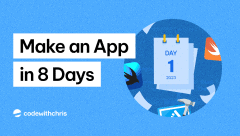Overview
The ternary operator in Swift is a concise way to evaluate a condition and return one of two values. It is often used as a shorthand for if-else statements, offering a more streamlined syntax. This article explores how to use the ternary operator in Swift, including cases without an else clause and formatting it across multiple lines for better readability.
Swift Ternary Operator Example
// Basic Usage
let isSunny = true
let weatherMessage = isSunny ? "It's sunny outside!" : "It's cloudy outside."
print(weatherMessage) // Output: It's sunny outside!Code Explanation
- The ternary operator consists of three parts: a condition, a true expression, and a false expression. It is structured as
condition ? trueExpression : falseExpression. isSunny ? "It's sunny outside!" : "It's cloudy outside.": The ternary operator checks ifisSunnyis true (?). If so, it returns “It’s sunny outside!” (true expression); otherwise (:), it returns “It’s cloudy outside.” This is equivalent to a simple if-else statement but is more compact.
Ternary Operator Without Else Clause
The ternary operator typically requires both a true and false expression. However, you can use it in situations where the else case returns nil or a default value.
Without Else Clause Example
// Without Else Clause
let score = 85
let result: String? = score > 60 ? "Pass" : nil
print(result ?? "No result available") // Output: PassWithout Else Clause Explanation
let result: String? = score > 60 ? "Pass" : nil: Assigns “Pass” if the score is above 60; otherwise,resultisnil. The??operator can provide a default value whenresultisnil, ensuring safe unwrapping.
Ternary Operator on Multiple Lines for Readability
When using the ternary operator with longer expressions, formatting it across multiple lines can improve readability.
Multiple Lines Example
// Multiple Lines for Readability
let temperature = 30
let temperatureStatus = temperature > 0 ?
"Above freezing point" :
"Below freezing point"
print(temperatureStatus) // Output: Above freezing pointMultiple Lines Explanation
- The ternary operation is split into separate lines, making it clearer and easier to maintain. This is especially useful for longer or more complex expressions, enhancing code readability.
The ternary operator in Swift offers a neat and concise way to execute conditional statements. It can replace simple if-else blocks, making the code shorter and more readable. However, it is best used for straightforward conditions, as overusing it for complex logic can make the code harder to understand. By mastering the ternary operator, Swift developers can write more efficient and elegant code.




